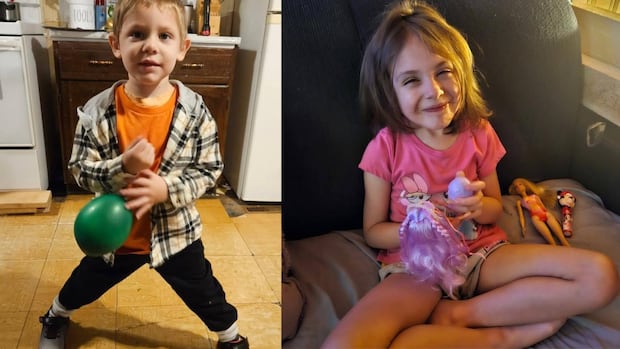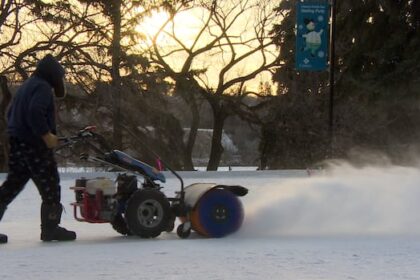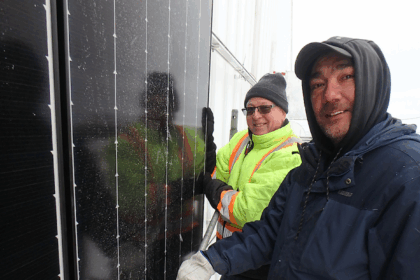Sunny Austin sits in front of a microphone at a small desk in the corner of her bedroom as she settles in to host a livestream centred around two young children who have been missing from Nova Scotia for nearly five months.The YouTuber often spends hours a day discussing Jack and Lilly Sullivan with hundreds of people from around the world, their comments popping up on the screen as Austin dissects every aspect of the mysterious case.Some of the commenters’ names stand out: Belynda Gray. Daniel Martell. Darin Geddes. They are all members of the children’s family.”YouTubers, the true crime community … we can sit there and keep these cases alive,” Austin, known online as Sunny Justice, said in a virtual interview from her home in Langley, B.C.”It’s really about being a voice for the victims, and that’s really the core of everything.”Austin’s show, It’s A Criming Shame, is one of many crime shows on YouTube that have been discussing the case of Lilly, 6, and Jack, 4, who vanished from their home in Lansdowne Station, N.S., on the morning of May 2.These types of shows mark an evolution in how people engage with crime and mysteries — it’s never been more interactive. They create opportunities for those directly involved in cases to speak their minds.But that comes with both benefits and pitfalls. While police say the discussions can and have led to real-world leads, they and other experts also raise ethical concerns about potentially reducing people who are already suffering to consumable and often monetized content.WATCH | How online discussions around missing N.S. children mark evolution in true crime:What true crime shows mean for missing children’s familyTrue crime shows are marking a change in how people engage with crime and mysteries, and it’s playing out in real time in the case of missing Nova Scotia children Jack and Lilly Sullivan.A ly Thomson dives into the dynamics of the ethical issues at play.Austin started her show five years ago after becoming enthralled with the 2020 disappearance of Suzanne Morphew in Colorado, whose body wouldn’t be found for three years. Her husband has been charged in her death.Since then, the 56-year-old woman has amassed about 18,000 subscribers and tens of thousands of views on her videos.Multiple times a week, Austin returns home from work as a full-time customer service representative in the hospitality industry and sits down at her computer for hours-long live discussions about Jack and Lilly. She is sometimes joined by co-host Sharmain Swart of the True Crime Story Podcast.The siblings were reported missing by their mother, Malehya Brooks-Murray, who told police they wandered away from their rural mobile home. But an extensive search of nearby dense woods turned up little evidence, apart from a pink blanket.Meanwhile, Brooks-Murray and the children’s stepfather, Daniel Martell, have been estranged since the day after the disappearance, as rumours continue to swirl online.Austin doesn’t pretend to be a journalist, but rather an alternative to traditional media allowing for more open discussions — and she acknowledges not everything said is based in truth.Jack Sullivan, 4, and his sister Lilly, 6, are seen in family photos. (Submitted)On Sept. 19, Austin went live to discuss the announcement that police would be bringing in cadaver dogs as part of the investigation. About halfway through the video, a comment from Martell appears.”I should release all the information I brought to major crimes that would point fingers!! It’s undeniable and I hold back,” wrote Martell.Despite acknowledging that unfounded theories do arise on her show, Austin feels she is helping raise the case’s profile.”I’m here for the advocacy of the victim. I’m not here for lies and mistruths,” said Austin, who has a 28-year-old son.Belynda Gray, the children’s paternal grandmother, began watching Austin’s videos amid a lack of answers about the case. She wasn’t being kept informed by police, as only an unnamed family designate receives those updates.Desperate for answers about her missing grandchildren, Belynda Gray says she regularly monitors at least 10 true crime shows on YouTube. (Aly Thomson/CBC)”In the beginning, it was my only way to get any information,” Gray said during a recent interview at her home in the Musquodoboit Valley.As she sits at her kitchen table, with posters and photos of Jack and Lilly pinned on the fridge nearby, she lists off at least 10 true crime shows she regularly monitors on YouTube.Before her grandchildren went missing, she had “no idea that world even existed.”She started speaking with Austin over Facebook Messenger early in the investigation, and the two have become friends. Gray sometimes appears as a guest on the show. She says it allows her to dispel hearsay and get her side of the story out there.For example, in the beginning, there were rumours her son, Cody Sullivan, was incarcerated in Western Canada. In fact, there is someone with that name who was facing criminal charges in B.C., but it’s a coincidence and not her son.Gray has also connected with a B.C. lawyer through Austin’s show who is helping her — pro bono — explore her legal rights regarding the children.Her son decided not to be in the children’s lives when he and Brooks-Murray broke up about three years ago, but Gray nevertheless remained involved with Jack and Lilly. During visits with their grandmother, Lilly often helped her in the garden and Jack played quietly with toy dump trucks and tractors.She announced on It’s A Criming Shame that she would be seeking temporary legal guardianship of the children, in order to be kept more informed about the case by police and to help care for them in the event they are found.Posters of the missing children are displayed on Belynda Gray’s fridge. (Aly Thomson/CBC)”I look at YouTube as a great tool. Can it run amok? It sure can. But it is still a great tool if you use it the right way,” said Gray, who has been saying for months she doesn’t believe the children are alive.”To me, the more people that talk about Jack and Lilly, the better it is. I don’t care who they are. They can state whatever they want that isn’t true. I don’t care because people are listening and Jack and Lilly’s name is still out there.”Online true crime shows, and social media in general, often bring an influx of tips to police.In this case, investigators have been following up on more than 800 tips, some of which were submitted as a direct result of the true crime shows that are covering the case, Nova Scotia RCMP confirmed.Sgt. Chris Marshall, commander of the Southwest Nova Major Crime Unit, said generally speaking, these sorts of tips can and have helped move investigations forward.He said social media does help bring cases in front of new audiences who may have pertinent information. For example, he said police once became aware of someone involved in a case that was not previously known to investigators.Sgt. Chris Marshall is the commander of the RCMP’s Southwest Nova major crime unit. He’s not directly involved in investigating the case of Jack and Lilly Sullivan. (Galen McRae/CBC )”My experience is that there is a big benefit. But it’s like anything, there’s risk and reward to anything that we do,” said Marshall, who is not directly involved in Jack and Lilly’s case.But there are downsides.Some tips are simply not factual, and police might know this from the outset, but they are required to do their due diligence and investigate it fully, which ties up police resources, said Marshall.”We now have to put investigators on that information, which is taking people away from potentially chasing down actual, real leads that are actually, you know, based in fact,” he said.The disappearance of Lilly and Jack Sullivan sparked an extensive grid search that spanned 8.5 square kilometres and involved about 160 ground search and rescue volunteers, service dogs, drones and helicopters. (Jeorge Sadi/CBC)Marshall also said that while some information being shared online is factual, it can sometimes get clouded with misinformation and give undue credence to rumours and theories.”The difficulty becomes when people take everything that comes out of these as proven fact, when often there’s very little that’s done to actually prove that any of the information is actually factual,” he said.Whitney Phillips, an associate professor of information politics and media ethics at the University of Oregon in Eugene, Ore., said there are major ethical issues with discussing such cases on platforms like YouTube.Phillips said click-based web engagement is designed to “flatten” real-world events — including trauma and human suffering — into commodified content.She said the “attention economy” has long driven popular culture and news, in that the most intriguing, shocking and upsetting information is what people respond to and engage with.But that can reduce victims of crime and their families to a consumable product.”I think it’s important to remember that every single story that unfolds online — it’s real people,” Phillips said in a recent interview.”But our online systems and the attention economy incentivize it so that we’re not always thinking about the actual people.”Whitney Phillips is an associate professor at the University of Oregon in Eugene, Ore., who teaches a media ethics course with a focus on true crime. (Jeremy Parker/University of Oregon)She said there are also issues around consent. Families might initially agree to discuss the case online, but that can change, and at that point, “their story essentially belongs to the internet.”With all that said, the attention economy is inescapable, said Phillips. That’s why content creators have a responsibility to understand these dynamics and consciously make choices that prioritize ethical considerations over engagement.”So just caring about the outcome is not actually enough to guarantee a positive outcome for all people involved. That is one of the tricky elements of the attention economy. It doesn’t care about your motives,” she said.”I believe that content producers, including everyday citizens sharing information, have a responsibility of understanding what their digital technologies might not be wanting them to see in terms of the human impact, the human consequences.”Sunny Austin, host of the YouTube show It’s A Criming Shame, says she considers herself an advocate for the victims of crimes and their families. (Submitted by Sunny Austin)Sitting next to a painting of the two children on her wall, Austin concedes that this case has stretched her beyond what she normally commits to her YouTube show.She admits that she does make money off her channel, through YouTube and donations, but that’s not why she’s doing it.”We just keep fighting for people to share to the algorithm to keep the story out there,” said Austin. “We do it for Jack and Lilly.”
With few answers and rumours abounding, family of missing N.S. children take to YouTube











